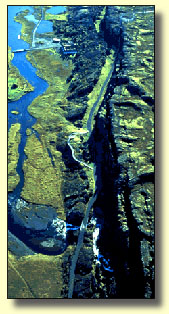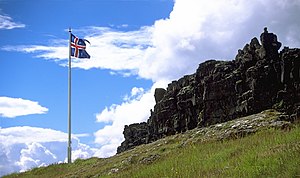
By Michelle Styles
Iceland is one of the most geographically interesting places on the planet. Besides, the thermal springs, the glaciers, and the volcanoes, it boasts of a land-based rift valley. A rift valley is formed when two continental plates are physically tearing apart. Mostly this happens in one of the world's oceans, but in Iceland, the Eurasian and the North American plates are moving apart and have created a rift valley at Thingvellir.
 The region around Thingvellir is an other-worldly landscape, where ropes of lava cut through the walls of the valley. Two great rock mountains--Hrafnabjorg and Armannsfell, where the mythical guardian of the region, Armann Dalmannsson, is supposed to dwell--rise above the valley. It looks as if nothing ever changes. Nature at one of its most majestic. However, every year the plates continue to drift apart by approximately 1.5 cm. This means that the valley floor is constantly changing, generally dropping by a few millimeters each year. In 1789 after an earthquake, the floor dropped by half a meter.
The region around Thingvellir is an other-worldly landscape, where ropes of lava cut through the walls of the valley. Two great rock mountains--Hrafnabjorg and Armannsfell, where the mythical guardian of the region, Armann Dalmannsson, is supposed to dwell--rise above the valley. It looks as if nothing ever changes. Nature at one of its most majestic. However, every year the plates continue to drift apart by approximately 1.5 cm. This means that the valley floor is constantly changing, generally dropping by a few millimeters each year. In 1789 after an earthquake, the floor dropped by half a meter.
For Icelanders, it is hard to underestimate the historical importance of Thingvellir as it is where the Icelandic chieftains or godar first met to form the Althing or General Assembly. One man was elected as the lawspeaker. The great Icelandic poet, Snorri Snorrisson served as the law speaker in the 12th century, for example.
 The Althing was held for two weeks every summer, and everyone who could attend did so. They lived in tented camps called buds and disputes were settled, laws given and democracy flourished. In the year 1000, it was here that Christainty was proclaimed as the national religion.
The Althing was held for two weeks every summer, and everyone who could attend did so. They lived in tented camps called buds and disputes were settled, laws given and democracy flourished. In the year 1000, it was here that Christainty was proclaimed as the national religion.
As various Icelandic sagas make clear, the Althing did not necessarily posses the power to enforce its laws, and sometimes, such as in Njal's saga, the disputes led to bloody feuds. Public executions began to take place in the 16th century. For example in the pools of Oxara, women convicted of witchcraft or sexual offences were drowned.
The last Althing met in 1798 in Thingvellir and was replaced by a national court and parliament in Reykjavik (also now called the Althing), but despite the move, the valley has never been forgotten. It served to inspire poets as well as the nationalist movement in the nineteenth century. When Iceland was granted its independence from Denmark in 1944, the declaration was read out at the historic site of the Althing in Thingvellir.
Today, it is a popular tourist destination and many come to marvel at Nature's power. But to Icelanders, it also represents the soul of their nation.
Iceland is one of the most geographically interesting places on the planet. Besides, the thermal springs, the glaciers, and the volcanoes, it boasts of a land-based rift valley. A rift valley is formed when two continental plates are physically tearing apart. Mostly this happens in one of the world's oceans, but in Iceland, the Eurasian and the North American plates are moving apart and have created a rift valley at Thingvellir.
 The region around Thingvellir is an other-worldly landscape, where ropes of lava cut through the walls of the valley. Two great rock mountains--Hrafnabjorg and Armannsfell, where the mythical guardian of the region, Armann Dalmannsson, is supposed to dwell--rise above the valley. It looks as if nothing ever changes. Nature at one of its most majestic. However, every year the plates continue to drift apart by approximately 1.5 cm. This means that the valley floor is constantly changing, generally dropping by a few millimeters each year. In 1789 after an earthquake, the floor dropped by half a meter.
The region around Thingvellir is an other-worldly landscape, where ropes of lava cut through the walls of the valley. Two great rock mountains--Hrafnabjorg and Armannsfell, where the mythical guardian of the region, Armann Dalmannsson, is supposed to dwell--rise above the valley. It looks as if nothing ever changes. Nature at one of its most majestic. However, every year the plates continue to drift apart by approximately 1.5 cm. This means that the valley floor is constantly changing, generally dropping by a few millimeters each year. In 1789 after an earthquake, the floor dropped by half a meter.For Icelanders, it is hard to underestimate the historical importance of Thingvellir as it is where the Icelandic chieftains or godar first met to form the Althing or General Assembly. One man was elected as the lawspeaker. The great Icelandic poet, Snorri Snorrisson served as the law speaker in the 12th century, for example.
 The Althing was held for two weeks every summer, and everyone who could attend did so. They lived in tented camps called buds and disputes were settled, laws given and democracy flourished. In the year 1000, it was here that Christainty was proclaimed as the national religion.
The Althing was held for two weeks every summer, and everyone who could attend did so. They lived in tented camps called buds and disputes were settled, laws given and democracy flourished. In the year 1000, it was here that Christainty was proclaimed as the national religion.As various Icelandic sagas make clear, the Althing did not necessarily posses the power to enforce its laws, and sometimes, such as in Njal's saga, the disputes led to bloody feuds. Public executions began to take place in the 16th century. For example in the pools of Oxara, women convicted of witchcraft or sexual offences were drowned.
The last Althing met in 1798 in Thingvellir and was replaced by a national court and parliament in Reykjavik (also now called the Althing), but despite the move, the valley has never been forgotten. It served to inspire poets as well as the nationalist movement in the nineteenth century. When Iceland was granted its independence from Denmark in 1944, the declaration was read out at the historic site of the Althing in Thingvellir.
Today, it is a popular tourist destination and many come to marvel at Nature's power. But to Icelanders, it also represents the soul of their nation.